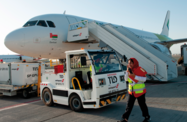Oman is looking to boost investment in its transport and logistics sector, one of five pillars targeted under the country’s Ninth Five-Year Development Plan (2016-20).
Plans to develop the sector are to be carried out through the Sultanate of Oman Logistics Strategy (SOLS) 2040, which aims to double employment in the sector to 80,000, as well as double its GDP contribution to OR3bn ($7.8bn) by 2020.
New foundations
To this end, in June the Sultanate established a new holding company – Oman Global Logistics Group (OGLG) – to consolidate state holdings in the country’s seaports, free zones, and maritime and land transport companies. OGLG will also be responsible for implementing SOLS, supervised by the Ministry of Transport and Communications.
Industry leaders have welcomed the move, saying it will help align strategic developments in the country’s transport and logistics sector.
“The creation of OGLG should help improve collaboration and coordination in the sector and boost synergies between stakeholders,” Reggy Vermeulen, CEO of the Port of Duqm, told OBG. “This move will help further establish Oman as a serious logistics hub in the region and will boost our competitive edge.”
A separate company with a similar mandate is expected to be established to manage Oman’s civil aviation sector, according to press reports. The company will hold the government’s stakes in Oman Air, Oman Airport Management Company and National Aviation Company.
Investing in ports
The creation of OGLG comes as Oman continues to inject money into its three major commercial ports at Duqm, Salalah and Sohar in a bid to attract investors and shipping lines.
A 2040 master plan for Sohar Port and Free Zone – located about two hours from Muscat – is currently being finalised, according to media reports from October.
The 2000-ha port area, which has already received $26bn in investment over a decade of operations, has a capacity of 1.5m twenty-foot equivalent units (TEUs). This is expected to increase to 5m TEUs by 2020 following the completion of a new container terminal.
With 95% of the free zone already developed or leased to investors, there are also plans to expand the industrial area by up to 50% in the near future.
Oman’s two other major commercial ports are also expected to undergo significant expansions.
As part of its planned phase three development, the Port of Salalah in the south of the country will see the investment of several hundred million dollars to develop three new container berths, new government berths and a dedicated cruise terminal, among other projects.
The Port of Duqm will likewise receive substantial investment following the recent awarding of a contract to build the terminal infrastructure for the port’s 2.2km commercial quay, which was completed in 2012.
The OR107m ($277.8m) contract was awarded to Serka Taahhut Insaat, the construction unit of Turkish firm Abdali Holding, for the construction of a pair of container terminals, which will have a combined 3.5m-TEU capacity upon completion in mid-2019.
Gaining the edge
While increased infrastructure investment will help Oman position itself as a viable alternative to other ports in the region, industry stakeholders are also hoping the government bears in mind the country’s overall competitiveness, as authorities move to reform subsidies and introduce new taxes in an effort to shore up public finances, which have been impacted by low oil prices.
“In a regional context, we have to ensure that we do not price ourselves out of the market,” Mark Geilenkirchen, CEO of the Port of Sohar, told OBG. “Any measures that increase the cost of doing business should be taken with consideration of what our neighbours are doing. We must constantly examine our prices, infrastructure, labour and efficiencies vis-à -vis our competitors.”
Oxford Business Group is now on Instagram. Follow us here for news and stunning imagery from the more than 30 markets we cover.

